Hello World!
This is me – first day of school, many years ago. 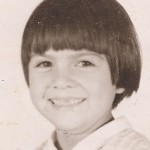
I was bright-eyed and full of anticipation and excitement when my big sister Rosie took me by the hand to deliver me to our one-room schoolhouse on the hill, a school ruled by the stern white-haired and stiffly-permed Mrs. Thiffault. As you can see, I was missing a front tooth and I had a bad hair cut, courtesy of my dad’s barber in Little Current, Ontario. Is there anything more embarrassing for a little girl than sharing a barber with her dad and other gentlemen? The only good thing about the barber experience was the red leather chair that spun around and made you dizzy.
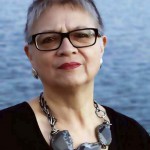 This is me now – first post, 2012. No longer missing a front tooth (you’ll have to trust me on that!) and I now see a hair styist, not a barber. Maybe no longer a bright-eyed innocent, but still full of excitement and anticipation for this new web site of mine. I’m a First Nations jewellery designer and this web site will showcase and show off my designs and I’ll give you some information about gemstones and sometimes, things Aboriginal.
This is me now – first post, 2012. No longer missing a front tooth (you’ll have to trust me on that!) and I now see a hair styist, not a barber. Maybe no longer a bright-eyed innocent, but still full of excitement and anticipation for this new web site of mine. I’m a First Nations jewellery designer and this web site will showcase and show off my designs and I’ll give you some information about gemstones and sometimes, things Aboriginal.
I’m wearing one of my designs – a necklace with polished and facetted Agate slices that are black and grey and paired with gunmetal grey vintage chain. People often ask me where the stones come from so that’s something I’ll tell you. Most Agate comes from Uruguay and Brazil where there are huge deposits, but it’s also found in several other places – Mexico, Madagascar, Italy, Egypt, India and Scotland.
I’ve been designing jewellery for the last several years, mostly self-taught but I’ve also worked with some enormously talented artists. Jewellery has been a huge passion of mine ever since I was about seven or eight years old when I got my first ring. My dad used to work for American tourists who had camps in the Bay of Islands (Ontario) and one summer, one of them arrived bearing silver rings from Mexico for all the sisters who were still living at home (I have six sisters). I got a beautiful wrap ring with abalone embedded in the silver and I wore it till I lost it swimming a few years later. But that little silver ring is what got me hooked on jewellery!
More of My Designs
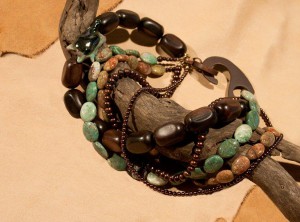 This is a 5-strand necklace with 2 strands of Bloodstone, 2 strands of Freshwater Pearls and one strand of Ebony Wood. The clasp is an Italian-made resin hook clasp. Nestled among the Ebony beads is a Porcelain Turtle.
This is a 5-strand necklace with 2 strands of Bloodstone, 2 strands of Freshwater Pearls and one strand of Ebony Wood. The clasp is an Italian-made resin hook clasp. Nestled among the Ebony beads is a Porcelain Turtle.
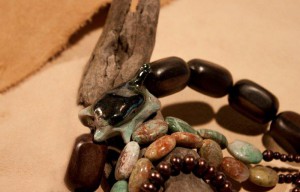 Here’s a close-up of the Turtle creeping between the barrel-shaped Ebony beads.
Here’s a close-up of the Turtle creeping between the barrel-shaped Ebony beads.
About Bloodstone
Bloodstone is also called heliotrope. It is a green spotted variety of chalcedony. The red on the dark green, caused by iron oxide, makes it such a gorgeous and versatile stone. India is the primary source of bloodstone, but it is also mined in Brazil, China, Australia and the US.
More Turtles
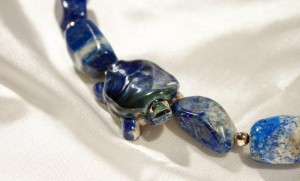 Another Porcelain Turtle, this time crawling among chunks of blue stones. You can see the full necklace below.
Another Porcelain Turtle, this time crawling among chunks of blue stones. You can see the full necklace below.
The blue stones are Lapis Lazuli, the spacers and accent bead are gold-filled and I’ve included a double strand of vintage brass chain. The toggle clasp is gold vermeil.
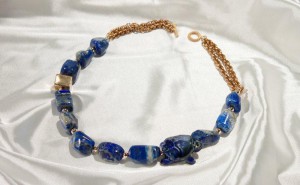 About Lapis Lazuli
About Lapis Lazuli
Lapis is a blue stone actually made up of several minerals including lazurite, sodalite, calcite and pyrite. The goldish-coloured specks you often see on lapis is pyrite which is a brassy yellow. The best quality lapis comes from Afghanistan. Lapis is said to enhance self-expression, self-awareness and spiritual communication.
The porcelain turtles in these two necklaces are made by a ceramic artist named Vera who I met at the Toronto Bead Society Show a few years ago. I bought all she had at the show – three or four – and asked her for more. And she brought me more in different shades of greens and browns. I can’t believe how nicely they go with so many stones!
And Still More Turtles
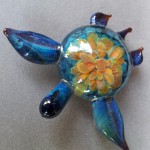 I found this glass sea turtle pendant at The Beadery on Queen Street in Toronto. It was hand-made by an Australian glass artist.
I found this glass sea turtle pendant at The Beadery on Queen Street in Toronto. It was hand-made by an Australian glass artist.
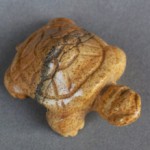 This Picture Jasper turtle came from a gem show in Toronto.
This Picture Jasper turtle came from a gem show in Toronto.
This is Chief Shining Turtle, Chief of Whitefish River First Nation with his daughter 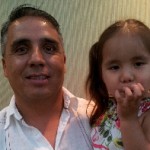 Lucy. Whitefish River, also known as Birch Island and “the place of visions and dreams” is my home. Birch Island is near Manitoulin Island in the heart of what is known as Rainbow Country after a Canadian TV series that was filmed there in the 1960’s. Lois Maxwell, of Miss Moneypenny fame in the early James Bond movies, played the lead.
Lucy. Whitefish River, also known as Birch Island and “the place of visions and dreams” is my home. Birch Island is near Manitoulin Island in the heart of what is known as Rainbow Country after a Canadian TV series that was filmed there in the 1960’s. Lois Maxwell, of Miss Moneypenny fame in the early James Bond movies, played the lead.
Ooops…This is not a Turtle. It’s a Tortoise
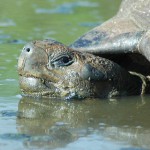 My friend Frida Ardal travelled with her still active and beautiful 80+ year old mother to the Galapagos in 2006. (The trip was her adventurous mother’s idea.) Frida’s a photographer, specializing in nature photos, and she took some wonderful photos of the Giant Tortoise. The difference between turtles and tortoises? Turtles live primarily in water. They have webbed front feet or flipper-like fins to make swimming easier. Tortoises live almost exclusively on land, don’t need and don’t have webbed feet or flippers, and only enter water to drink or wash themselves off. Turtles are omnivorous while tortoises eat only plants, leaves and other vegetation.
My friend Frida Ardal travelled with her still active and beautiful 80+ year old mother to the Galapagos in 2006. (The trip was her adventurous mother’s idea.) Frida’s a photographer, specializing in nature photos, and she took some wonderful photos of the Giant Tortoise. The difference between turtles and tortoises? Turtles live primarily in water. They have webbed front feet or flipper-like fins to make swimming easier. Tortoises live almost exclusively on land, don’t need and don’t have webbed feet or flippers, and only enter water to drink or wash themselves off. Turtles are omnivorous while tortoises eat only plants, leaves and other vegetation.
There’s also a difference in their shells. 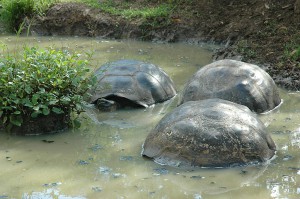
Turtles have a flatter shell and the shells of tortoises are more domed as you can see in the photo of three tortoises bathing.
Why Turtles?
Turtles have special importance to Aboriginal people. I’ll talk about that next time and I’ll show more pictures of my jewellery. Thanks to Frida for letting me use her tortoise photos! Photos of my jewellery are by Gio Petrucci. My husband took the 2012 photo of me.
Leave a Reply